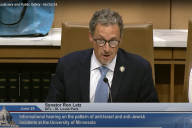You have /5 articles left.
Sign up for a free account or log in.
For some students, plans to attend college take shape during high school. But according to researchers, high school can be too late to start planning -- financially and academically.
A new study released by the Urban Institute today, available on its website at 10 a.m., identifies new ways to help make middle schoolers and their families aware of their financial aid options, letting them know that college can be a reality for those who might think they can't afford it.
Looking at programs such as free- and reduced-price lunch programs, the Supplemental Nutrition Assistance Program (SNAP), and Medicaid, in which many of the participants would be eligible for Pell Grants, the authors found the best way to spread information on financial aid isn't to rely on one solution, but instead requires a multifaceted approach to engage as many potential applicants as possible.
Sandy Baum, one of the report’s authors and a senior fellow at the Income and Benefits Policy Center at the Urban Institute, said students and their families should be made aware of their options as soon as possible. “What happens is a lot of low-income students think they’re not able to go to college, so they don’t work hard or take the right courses,” Baum said.
The gap in financial aid awareness isn't news to those in higher education -- a 2011 study by the College Board found that while students and parents said federal financial aid should be a priority of the federal government, many were unaware of Pell Grants and other forms of aid.
The report also identified the federal tax filing system, as well as businesses like H&R Block that help to prepare taxes, as possible partners to help share information on financial aid. Of the 145 million federal income tax returns filed in 2012, 47 percent reported a household income of less than $30,000 for the year and 26 reported less than $15,000.
Sarah Minton, a research associate at the Income and Benefits Policy Center at the Urban Institute, who also co-authored the report, said she and Baum gathered feedback from organizations they thought might be able to play a role in sharing the information.
“They had a lot of interest in this, in what the most feasible and effective option for getting this information out was,” Minton said.
But privacy hurdles, like asking those using the other programs if they’d like to receive the information on federal financial aid, could prevent some from finding out about opportunities for their children.
Baum said that as the research on spreading awareness continues, researchers will have to look at how exactly they will share the information, whether it’s in the form of brochures or a caseworker sharing the information in person.
Timing also plays an important role, Baum noted -- those who are filing taxes or for benefits are more concerned with the outcome of those applications than they are with finding alternative sources of funding for the education of a child who is still years away from the college application process.
And the younger the child is, the less of the parents’ time is spent planning for college, as they pay attention to more pressing matters.
“Some say it’s important to do before the end of high school to give people a chance to prepare, some people say it should happen when the baby’s born to make a big difference,” Baum said. “I don’t think we have enough evidence on when the most important time is.”







